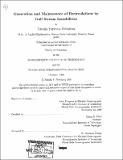| dc.contributor.advisor | Glenn R. Flierl.For strong bottom friction, the 2-layer model has only the mechanism of barotropic instability which reduces it to a 1-layer configuration; the model displays two dynamical regimes and strong low frequency variability in the upper layer, while the lower layer is strongly frictional. | en_US |
| dc.contributor.author | Beliakova, Natalia Yurievna, 1967- | en_US |
| dc.contributor.other | Woods Hole Oceanographic Institution. | en_US |
| dc.date.accessioned | 2010-09-14T18:06:48Z | |
| dc.date.available | 2010-09-14T18:06:48Z | |
| dc.date.copyright | 1998 | en_US |
| dc.date.issued | 1999 | en_US |
| dc.identifier.uri | http://hdl.handle.net/1721.1/58539 | |
| dc.description | Thesis (Ph. D.)--Joint Program in Physical Oceanography (Massachusetts Institute of Technology, Dept. of Earth, Atmospheric, and Planetary Sciences; and the Woods Hole Oceanographic Institution), February 1999. | en_US |
| dc.description | Includes bibliographical references (leaves 220-224). | en_US |
| dc.description.abstract | This thesis studies the problems of generation and maintenance of recirculations by Gulf Stream instabilities. Observations show that the horizontal structure of the jet and its recirculations suffer significant changes in time. Here, the role of internal dynamics of the jet is isolated as one of the possible sources of such variability, and the differences between barotropic and baroclinic instabilities are investigated. The problem of recirculation development is considered in a framework of a free spin down of the 2-layer and the lI-layer, zonally symmetric, quasi-geostrophic jets. Linear stability analysis shows that in strongly baroclinic basic flows, eddies are capable of driving recirculations in the lower layer through the residual meridional circulation. In strongly barotropic jets, the linearly most unstable wave simply diffuses the jet. Nonlinear stability analysis indicates that recirculations are robust features of the 2-layer model. The strength of recirculations is a function of the model's parameters. It increases with a decrease in the value of the nondimensional # due to potential vorticity homogenization constrained by enstrophy conservation. The recirculation strength is a non-monotonic function of the baroclinic velocity parameter; it is the strongest for strongly baroclinic basic flows, weakest for flows with intermediate baroclinic structure and of medium strength for strongly barotropic basic flows. Such non-monotonic behavior is the result of two different processes responsible for the recirculation development: linear eddy-mean flow interactions for strongly baroclinic basic flows and strongly nonlinear eddy-eddy and eddy-mean flow interaction for strongly barotropic flows. In the case of the reduced-gravity model, recirculations develop only for infinite deformation raduis. Basic flows with finite deformation radius are only weakly supercritical and therefore produced negligible recirculations after equilibration. The problem of maintenance of the recirculations is coupled to the questions of existence of low frequency variability and of multiple dynamical regimes of a system consisting of a quasi-geostrophic jet and its recirculations. The problem is studied in a framework of a 2-layer or a reduced-gravity colliding jets model which has no windforcing. Instead, it is forced by inflows and outflows through the open boundaries. Only the western boundary of the domain is closed, and a free slip boundary condition is used there. The results of the numerical experiments show that when only the mechanism of barotropic instability is present, the model has two energy states for a wide range of interfacial friction coefficients. The high energy state is characterized by well-developed recirculations and displays strong variability associated with either large recirculating gyres and a weak eddy field or small recirculations and a strong eddy field. The low energy state is characterized by large meridional excursions in the separation point and large amplitude, westward propagating meanders that produce strong rings after interacting with the western wall. For physically relevant bottom friction values, the presence of baroclinic instability in the recirculation regions of the 2-layer model allows for a unique dynamical regime characterized by well-developed recirculations in both layers. The low-frequency variability associated with the regime is weak and is related to meridional shifts in the position of the jet, to wrapping of the recirculations around each other, and to pulsations in their zonal extent. | en_US |
| dc.description.statementofresponsibility | by Natalia Yurievna Beliakova. | en_US |
| dc.format.extent | 224 leaves | en_US |
| dc.language.iso | eng | en_US |
| dc.publisher | Massachusetts Institute of Technology | en_US |
| dc.rights | M.I.T. theses are protected by
copyright. They may be viewed from this source for any purpose, but
reproduction or distribution in any format is prohibited without written
permission. See provided URL for inquiries about permission. | en_US |
| dc.rights.uri | http://dspace.mit.edu/handle/1721.1/7582 | en_US |
| dc.subject | Joint Program in Physical Oceanography. | en_US |
| dc.subject | Earth, Atmospheric, and Planetary Sciences. | en_US |
| dc.subject | Woods Hole Oceanographic Institution. | en_US |
| dc.title | Generation and maintenance of recirculations by Gulf Stream instabilities | en_US |
| dc.type | Thesis | en_US |
| dc.description.degree | Ph.D. | en_US |
| dc.contributor.department | Joint Program in Physical Oceanography | en_US |
| dc.contributor.department | Woods Hole Oceanographic Institution | en_US |
| dc.contributor.department | Massachusetts Institute of Technology. Department of Earth, Atmospheric, and Planetary Sciences | |
| dc.identifier.oclc | 42583686 | en_US |

